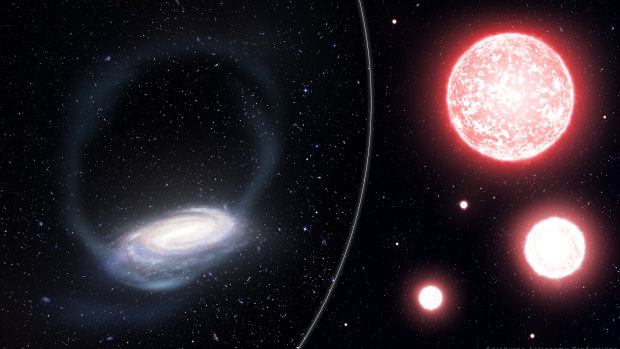By Liam Mannix
A group of ancient stars, perhaps the last remnants of the building blocks of the Milky Way, have been spotted by Australian astronomers.
The chance discovery is a rare opportunity to study our galaxy's evolution – even as the cluster of stars, known as the Phoenix stream, is in the process of being torn apart.
The stream sits in the stellar halo, a cold and largely empty expanse of space beyond the Milky Way, where it is slowly tracing a billion-year orbit of our galaxy.
"Phoenix represents one of the last remnants of an initial population that formed part of the building blocks of our galaxy," said University of Sydney astronomer Geraint Lewis.
"There would have been more of them, but over time the gravity of our galaxy would have torn them apart. Phoenix is the only example we have of the last of the originals," Professor Lewis said.
The last few years of astronomy have deeply changed the way scientists think about galaxy formation. It used to be imagined that galaxies formed whole out of vast clouds of gas left over from the Big Bang.
The new picture is more violent: the huge galaxies astronomers see are actually composites of many smaller galaxies and star clusters yanked together by gravity.
The Milky Way therefore contains a mix of new and old stars, complicating attempts to study the galaxy's evolution.
That is what makes discovery of the Phoenix stream, announced Thursday in Nature, so interesting.
"This new result is indeed exciting and significant," said Professor Richard de Grijs, a Macquarie University astrophysicist who was not involved in the research.

An artist’s impression of the thin stream of stars torn from the Phoenix globular cluster, wrapping around the Milky Way (left). Credit: James Josephides, Swinburne Astronomy
If the Phoenix stream really was a building block of the Milky Way, "that is exciting, because such objects would be composed of the earliest stars formed in the universe," he said.
The stars – there are about a million of them – exist in a clump outside our galaxy, orbiting it about 62,000 light years away from the sun.
And they are old – ancient enough to suggest they were part of a dwarf galaxy consumed many billions of years ago by the Milky Way.
Astronomers can work out the age of a star by looking at what it is made of. When the universe was shiny and new, it was mostly filled with the simplest elements: helium and hydrogen.
As the universe aged, stars have smashed these elements together into heavier elements, like the metals we see on Earth.
Young stars tend to have lots of these metals in their atmosphere because they formed in a more polluted universe. The oldest stars have relatively few.
Using the 3.9-metre Anglo-Australian telescope at Siding Spring in NSW, University of Sydney PhD student Zhen Wan was able to show the stars of the Phoenix Stream have almost no metal.
That makes the stars perhaps 10 billion years old. By way of comparison, the sun is 4.6 billion years old; the universe about 13.8 billion.
Astronomers have never seen a clump of stars like this.
"This stream comes from a cluster that, by our understanding, shouldn't have existed," said associate professor Daniel Zucker, a Macquarie University astronomer and co-author of the research.
Astronomers are unsure where this ancient cluster of stars comes from.
Professor Lewis suspects it may have orbited a dwarf galaxy that was long ago consumed by the Milky Way and now remains behind like interstellar trash.
And, eventually, it will be no more. The Milky Way's enormous gravity has already stretched the cluster out into a thin line, and over the next couple of billion years it will shred the cluster apart and mix the stars with itself.
"It's right on the cusp of surviving," said Professor Lewis.
"It's already been drawn into this huge extended stream – and if we wait for a couple more orbits, this stream will be dispersed and we'll have no more stream."
Get our Morning & Evening Edition newsletters
The most important news, analysis and insights delivered to your inbox at the start and end of each day. Sign up to The Sydney Morning Herald’s newsletter here, to The Age’s newsletter here and Brisbane Times' here.